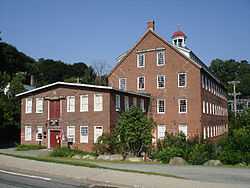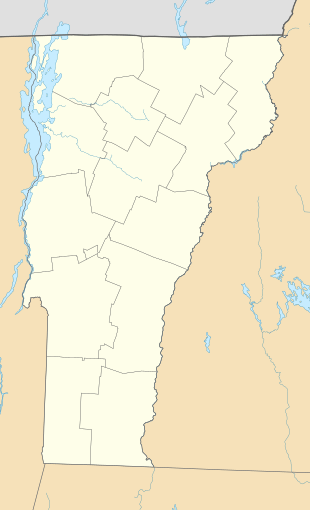American Precision Museum
|
Robbins and Lawrence Armory and Machine Shop | |
 | |
|
The American Precision Museum | |
 | |
| Location | S. Main St., Windsor, Vermont |
|---|---|
| Coordinates | 43°28′29″N 72°23′23″W / 43.47472°N 72.38972°WCoordinates: 43°28′29″N 72°23′23″W / 43.47472°N 72.38972°W |
| Area | 1.75 acres (0.71 ha) |
| Built | 1846 |
| Architect | Unknown |
| Architectural style | No Style Listed |
| Governing body | Private |
| NRHP Reference # | 66000796[1] |
| Significant dates | |
| Added to NRHP | November 13, 1966 |
| Designated NHL | November 13, 1966[2] |
The American Precision Museum is located in the renovated 1846 Robbins & Lawrence factory on South Main Street in Windsor, Vermont. The building is said to be the first U.S. factory at which precision interchangeable parts were made, giving birth to the precision machine tool industry. In recognition of this history, the building was declared a National Historic Landmark in 1966.[2][3]
A "machine tool" is a machine which makes parts to other machines, such as screws or gun stocks, generally without a skilled craftsman doing the precision work. Instead, a machine operator controls the machine as it does the precision work. Lathes, milling machines, and drill presses are precision machine tools. The museum has the largest collection of historically significant machine tools in the United States.
The museum is open daily from 10am until 5pm from Memorial Day Weekend through October. Admission is free on Sundays.[4]
History and importance
Richard S. Lawrence, a brilliant mechanic, moved to Windsor in 1838 at age 21 and started making guns in the Windsor Prison. He joined N. Kendall, who had a gun-making shop, and together started a new company. Four years later businessman Samuel E. Robbins came to Windsor and, with Lawrence and Kendall, procured a government contract to produce 10,000 guns. Over the next eight years, the factory was built and machines to make precision parts were made. Those early machines made parts precise enough to be interchangeable, the first achievement of that long-term goal. Later, Lawrence bought out Kendall.
There are two reasons that Robbins & Lawrence can be considered as founders of the precision tool industry. In 1851, Robbins and Lawrence traveled to London to demonstrate their rifles at the Great Exhibition, held in London’s Crystal Palace. The rifles were made in Windsor using interchangeable parts. They won a medal and so impressed the British Army that they placed an order for 25,000 Enfield rifles (this can't be true. Enfields were not available until the mid 1890s, well after the Crimean War.) for the Crimean War and also ordered 141 of the Robbins & Lawrence metal-working machines making the firm the first large-scale exporter of machine tools. Thus began the “American System” for producing interchangeable parts which accelerated the development of the precision tool-making industry that followed rapidly.
The second reason Robbins & Lawrence can be credited with the birth of the precision tool industry is the number of people who were employed at the factory that went on to work at, or found, other companies. J.W. Roe produced a "Genealogy of the Robbins & Lawrence Shop" which is reproduced here, with permission, from Lindsay Publications. With the development of interchangeable parts, machines of all sorts could be made in large numbers and sold more cheaply. The manufacture of sewing machines, typewriters, bicycles, engines and cars soon followed. Precision machine tools which makes standardized parts make the mechanical equipment of our modern world.

Current exhibit
The Civil War Sesquicentennial at the American Precision Museum: In 2012, the museum opened two new exhibitions commemorating the 150th anniversary of the U.S. Civil War, which will be at the museum through the 2014 season.
Full Duty: The Civil War Collection of Howard Coffin presents the first-ever exhibition from the private collection of Vermont's foremost Civil War historian and author. Featuring letters, diaries, photographs, maps, paintings, and newspapers, the exhibition explores the day-to-day life of Vermont soldiers in camp and on the battlefield. These artifacts and images explore how the actions and decisions of ordinary people can have an enormous impact on historic events.
Arming the Union: Gunmakers in Windsor, Vermont uncovers the influence of a little-known factory called Lamson, Goodnow & Yale. Operating out of the old Robbins & Lawrence armory in Windsor, the machine tool firm played a critical role in outfitting the Union Army. Altogether, the North produced more than 1.5 million rifles in the span of about three years, along with tens of thousands of pistols and carbines. The majority of those weapons were made using machinery designed and produced in Windsor. Arming the Union tells the story of the men and machines that made possible the production of guns on such a massive scale—the story of the technological achievement that saved the Union.
The two stories also overlap—and not simply because Vermont soldiers, like most in the Union Army, carried weapons produced on Vermont-made machinery. Half a dozen young men actually worked in the Windsor armory before shouldering rifles and heading off to war. Both exhibits are set inside the actual nineteenth-century factory building where the gunmaking machinery was perfected and built and where 50,000 Special Model 1861 rifle muskets were also produced by Lamson, Goodnow & Yale. Together these two exhibitions present a rarely seen view of Vermont's role in the Civil War.[5]
See also
- American system of manufacturing
- Industrial Revolution
- Machine tool builder
- Machine tools
- Machining
- List of National Historic Landmarks in Vermont
- National Register of Historic Places listings in Windsor County, Vermont
References
- ↑ "National Register Information System". National Register of Historic Places. National Park Service. 2008-04-15.
- ↑ 2.0 2.1 "Robbins and Lawrence Armory and Machine Shop". National Historic Landmark summary listing. National Park Service. Retrieved 2008-02-18.
- ↑ Polly M. Rettig, Horace J. Sheely and S. S. Bradford (December 2, 1974). "National Register of Historic Places Inventory-Nomination: Robbins and Lawrence Armory and Machine Shop; American Precision Museum / Robbins and Lawrence Armory and Machine Shop; Cotton Mill Building" (PDF). National Park Service. and Accompanying 5 photos, from 1966, 1974, and 1979 PDF (32 KB)
- ↑ "American Precision Museum". Retrieved 11 July 2012.
- ↑ Roe, Joseph Wickham (1987). English & American Tool Builders. Lindsay Publications, Inc. pp. Chapter XV. ISBN 0-917914-73-2.
External links
| ||||||||||||||||||||||||||
| ||||||||||||||||||||||||||